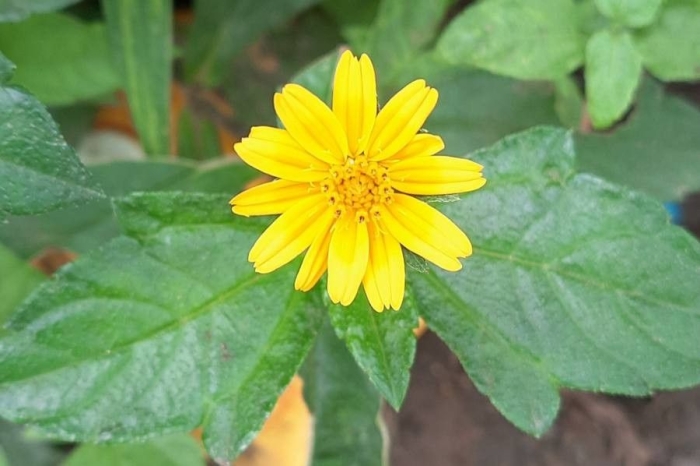Singapore Daisy
(Sphagneticola trilobata)
Singapore Daisy (Sphagneticola trilobata)
/
/

Arvind Kulkarni
CC BY-SA 4.0
Image By:
Arvind Kulkarni
Recorded By:
Copyright:
CC BY-SA 4.0
Copyright Notice:
Photo by: Arvind Kulkarni | License Type: CC BY-SA 4.0 | License URL: https://creativecommons.org/licenses/by-sa/4.0/ | Attribution: Arvind Kulkarni (cc-by-sa) | Rights Holder: Arvind Kulkarni | Publisher: PlantNet | Date Created: 2020-09-02T20:27:13Z | Title: Sphagneticola trilobata (L.) Pruski: flower | Notes: |







































































Estimated Native Range
Summary
Sphagneticola trilobata, commonly known as Singapore Daisy, is an evergreen perennial herb originally from tropical America, including Mexico, Central America, the Caribbean, and northern South America. It typically forms dense mats up to 30 cm in height, with rounded stems that can reach up to 40 cm in length, rooting at nodes with the flowering stems ascending. The plant is known for its vibrant yellow and orange flowers that bloom profusely in the spring, summer, and fall, adding a splash of color to the garden landscape.
Singapore Daisy is valued for its rapid growth and ground-covering ability, making it a popular choice for filling in bare spots and controlling erosion in warm climates. It thrives in full sun and requires low to medium amounts of water, adapting to a range of soil types with varying drainage. However, due to its aggressive growth and ability to root at the nodes, it can become invasive, outcompeting native vegetation and altering natural habitats. It is often used as an ornamental plant in gardens, but care should be taken to prevent its spread into natural areas. Propagation is primarily vegetative, as seeds are typically infertile. Gardeners should be aware of its invasive potential and manage its growth responsibly to prevent unwanted spread.CC BY-SA 4.0
Singapore Daisy is valued for its rapid growth and ground-covering ability, making it a popular choice for filling in bare spots and controlling erosion in warm climates. It thrives in full sun and requires low to medium amounts of water, adapting to a range of soil types with varying drainage. However, due to its aggressive growth and ability to root at the nodes, it can become invasive, outcompeting native vegetation and altering natural habitats. It is often used as an ornamental plant in gardens, but care should be taken to prevent its spread into natural areas. Propagation is primarily vegetative, as seeds are typically infertile. Gardeners should be aware of its invasive potential and manage its growth responsibly to prevent unwanted spread.CC BY-SA 4.0
Plant Description
- Plant Type: Herb
- Height: 0.5-2 feet
- Width: 2-6 feet
- Growth Rate: Rapid
- Flower Color: Yellow
- Flowering Season: Spring, Summer, Fall
- Leaf Retention: Evergreen
Growth Requirements
- Sun: Full Sun, Part Shade
- Water: Low, Medium
- Drainage: Slow, Medium, Fast
Common Uses
Bank Stabilization, Drought Tolerant, Groundcover, Low Maintenance
Natural Habitat
Originally from tropical America, including Mexico, Central America, the Caribbean, and northern South America
Other Names
Common Names: Creeping-Oxeye, Trailing Daisy, Wedelia Daisy, Creeping Oxeye, Goldcup, Wedelia, Wild Marigold, Bay Biscayne Creeping-Oxeye, Singapoer-Madeliefie, Ampelkrage
Scientific Names: , Wedelia trilobata, Sphagneticola trilobata, Wedelia paludosa, Wedelia carnosa, Thelechitonia trilobata, Complaya trilobata, Wedelia paludosa var. vialis, Wedelia brasiliensis, Silphium trilobatum
GBIF Accepted Name: Sphagneticola trilobata (L.) Pruski